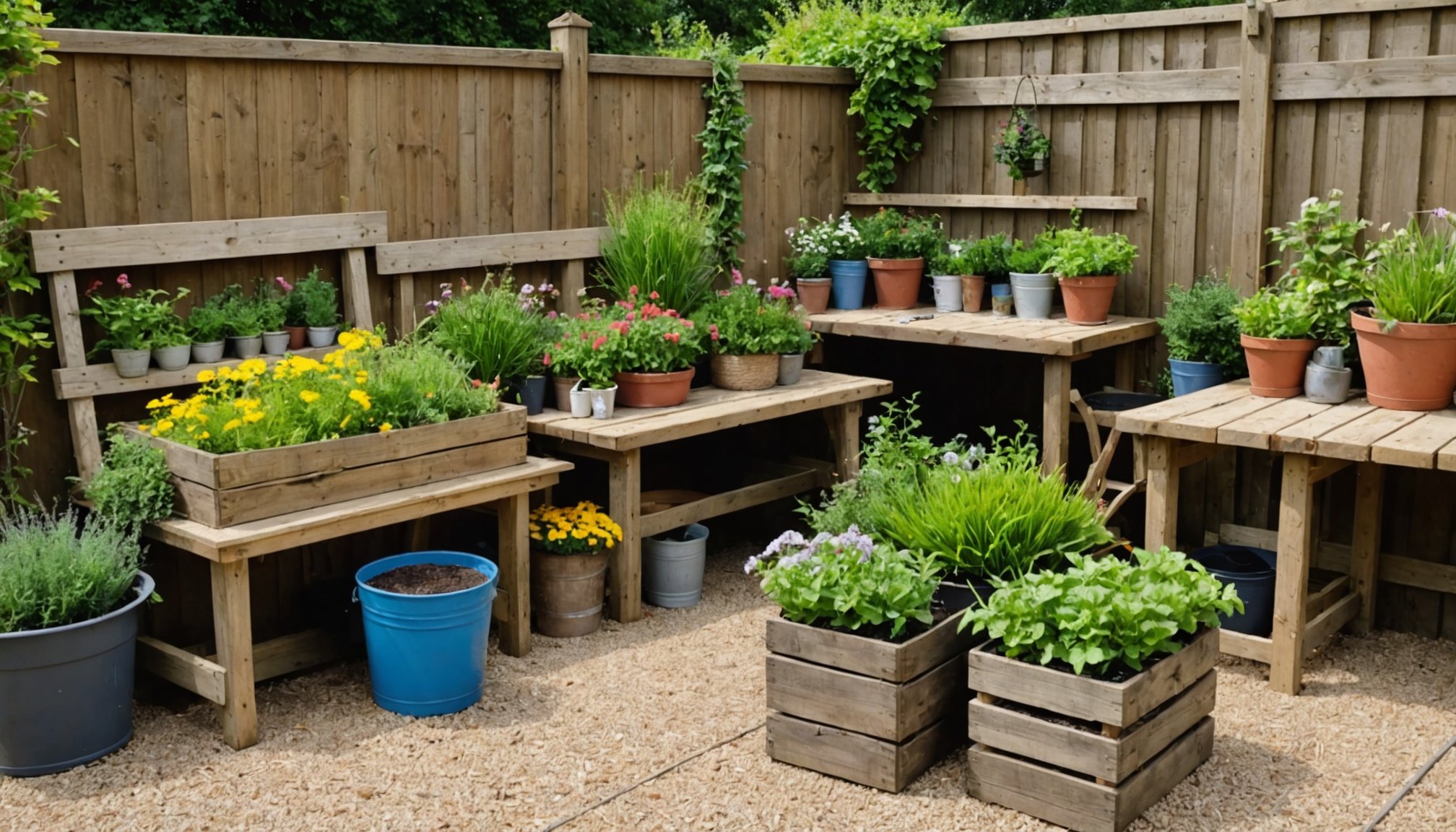Revamping your garden doesn’t mean a costly makeover. Embrace the charm of rustic aesthetics with recycled farm materials from the UK. Imagine wooden pallets repurposed into unique seating or old barrels transformed into plant pots. These eco-friendly solutions not only enhance your outdoor space but also reflect sustainability. Discover innovative ideas that can breathe new life into your garden while preserving its character. This approach offers both style and a story – allowing you to connect with nature and reduce waste.
Understanding Rustic Aesthetics in Gardening
Embracing rustic garden design involves creating a space that harmonizes with nature, often characterized by its simplicity and charm. This style draws inspiration from traditional UK countryside gardens, where the focus is on natural materials and a relaxed, informal layout. Elements such as weathered wood, stone paths, and native plants contribute to a garden that feels timeless and inviting.
A lire également : City Chickens: How to Raise Them in Your UK Garden Without Upsetting the Neighbors
Garden aesthetics play a crucial role in sustainable gardening, where the visual appeal is balanced with environmental responsibility. By incorporating rustic elements, gardeners can create spaces that not only look beautiful but also support local ecosystems. Using reclaimed materials and native plants reduces the ecological footprint and promotes biodiversity, aligning with sustainable gardening principles.
The UK countryside offers a wealth of inspiration for those looking to adopt rustic garden design. The rolling hills and picturesque landscapes provide a backdrop for gardens that blend seamlessly with their surroundings. Features like wildflower meadows, hedgerows, and natural water features can be adapted to fit various garden sizes, bringing a touch of rural charm to urban settings.
Cela peut vous intéresser : Unlocking the Potential of Greywater: A Practical Guide to Sustainable Gardening in UK Suburbs
Incorporating rustic aesthetics into your garden design can transform your outdoor space into a haven that is both visually appealing and ecologically sound.
Sourcing Recycled Farm Materials
Exploring recycled materials for your garden offers both aesthetic and environmental benefits. Farm materials such as old timber, metal troughs, and stone are ideal for incorporating rustic charm. These materials can be repurposed as planters, garden borders, or even decorative features, adding a unique touch to your outdoor space.
Finding recycled farm materials in the UK is more accessible than you might think. Local farms often have surplus or discarded items that can be reused. Additionally, farm auctions and reclamation yards are treasure troves for those seeking eco-friendly sourcing. Websites and community groups dedicated to recycling and upcycling can also be valuable resources.
The benefits of using local and sustainable sources extend beyond aesthetics. By choosing recycled materials, you reduce waste and support the local economy. Moreover, sourcing locally minimizes transportation emissions, aligning with eco-friendly practices. Embracing these methods not only enhances the rustic feel of your garden but also contributes positively to the environment.
Incorporating these elements into your garden design not only aligns with sustainable gardening principles but also ensures your garden is a reflection of the local landscape and community. By making informed choices, you can create a garden that is both beautiful and environmentally responsible.
Transformative Techniques for Your Garden
Embracing garden transformation can breathe new life into your outdoor space, especially with DIY techniques that highlight rustic charm. By using rustic garden projects, you can create a unique and inviting atmosphere.
Creative Uses for Reclaimed Wood
Reclaimed wood offers endless possibilities for rustic garden projects. It can be transformed into garden furniture, fences, or even raised beds. The weathered texture adds character, while being environmentally friendly. Using reclaimed wood aligns with sustainable practices, reducing the need for new materials.
Incorporating Metal Farm Equipment
Old metal farm equipment can be repurposed into stunning garden features. Think of using an antique plough as a decorative piece or turning metal troughs into planters. These items add an industrial touch, blending seamlessly with natural elements.
Designing with Natural Stone Elements
Natural stone can be a focal point in garden transformation. Use stones for pathways, borders, or even water features. Their durability and timeless appeal make them ideal for rustic designs. Stones also help in creating a natural flow, guiding visitors through the garden.
- Examples of successful transformations include using a mix of these materials to create a harmonious blend of textures and styles, enhancing both visual appeal and functionality.
Inspiring Rustic Garden Ideas
Exploring rustic garden ideas can elevate your outdoor space by merging timeless charm with modern innovation. By examining case studies of gardens that incorporate recycled materials, one can draw significant garden inspiration. For instance, a garden in Somerset uses old railway sleepers to create raised beds, blending rustic elements with contemporary design. This approach not only enhances visual appeal but also promotes sustainability.
Combining rustic elements with modern gardening techniques can yield stunning results. Imagine integrating solar-powered lighting with traditional stone pathways. This marriage of old and new not only highlights the garden's features but also supports eco-friendly practices. Moreover, using vertical gardening on reclaimed wood structures can maximise space while maintaining a rustic aesthetic.
Seasonal themes offer another layer of creativity to rustic garden design. In spring, consider planting wildflowers alongside antique metal farm tools for a burst of colour and nostalgia. Autumn can be celebrated with a display of pumpkins and gourds nestled among weathered wooden crates. These thematic elements provide year-round interest and charm.
These design concepts illustrate how rustic gardens can be both innovative and grounded in tradition, offering endless possibilities for those seeking to transform their outdoor spaces.
Maintenance and Longevity of Rustic Designs
Ensuring the longevity of rustic designs requires thoughtful garden maintenance and adherence to sustainable practices. To maintain the charm of recycled materials, regular inspection is vital. Check for signs of wear or decay, especially in wood and metal elements. Treat wood with natural oils or eco-friendly sealants to protect against weathering, preserving its rustic appeal.
Incorporating sustainable practices in your garden upkeep not only benefits the environment but also enhances the durability of your garden features. Use organic fertilizers and pest control methods to maintain plant health without harming the ecosystem. Mulching with natural materials like bark or leaves can help retain soil moisture and suppress weeds, reducing the need for chemical interventions.
To preserve rustic aesthetics, consider the natural aging process of materials as part of their charm. Embrace the patina that develops on metals and the weathered look of wood. If necessary, gently clean surfaces with natural solutions to maintain their appearance without stripping their character.
Tips for preserving rustic aesthetics include:
- Regularly prune plants to prevent overgrowth.
- Rotate decorative elements to avoid wear in one area.
- Use local plants that thrive in your climate, reducing maintenance needs.
DIY Projects for a Rustic Garden
Engaging in DIY garden projects can add a personal touch to your outdoor space while embracing the rustic charm. These hands-on gardening activities not only enhance your garden's aesthetics but also foster a deeper connection with nature.
Step-by-step Guide to Building a Reclaimed Wood Planter
Creating a planter from reclaimed wood is a rewarding rustic project. Start by selecting weathered wood pieces that are free from rot. Cut the wood to your desired size and assemble it into a rectangular or square shape using nails or screws. Ensure the structure is sturdy and add a lining to protect the wood from moisture. Finally, fill it with soil and your choice of plants.
Creating Garden Art from Old Farm Tools
Transform old farm tools into unique garden art. Select tools like shovels, rakes, or hoes, and arrange them artistically along a wall or as standalone sculptures. Their rustic appeal adds character and serves as a conversation piece.
Making a Rustic Garden Path with Stones
A stone path can guide visitors through your garden. Choose natural stones of varying sizes and lay them out in a desired pattern. Ensure each stone is level and secure to prevent tripping hazards. This DIY project enhances the garden's natural flow and rustic feel.











